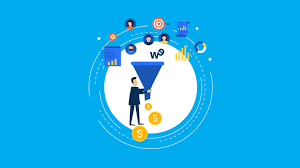What is Lead Scoring? Surely this is not the first time you have heard this term or read it on a blog. The truth is that if your lead capture or registration techniques are working, you surely already have a good database of potential customers that you will want to bring even closer to the purchasing process. But… are they all the same? Are they at the same stage of the purchasing process? Do they communicate with you?
To optimize your results you need to know what your leads are like, where they are in the Lead Nurturing process, and launch specific communications for each group of them. And this is achieved thanks to the qualification of leads or better known as Lead Scoring.
What is Lead Scoring?
Lead Scoring is an Inbound Marketing technique that measures or qualifies the degree of interest of your leads in the products or services that a company offers based on different parameters. Some of them are the proximity of that lead to your ideal client (buyer persona ), interactions with the website, communication of this user with the company or the stage of the purchasing process in which they are located.
In other words, through Lead Scoring we will try to measure the “temperature” of a lead to know the possibilities of converting it into a final customer or not and adapt our communications to this.
The theory is very good, but let’s move on to practice so that you get an idea of what exactly lead scoring is. Imagine that you have launched a lead capture campaign through a form on a landing page. Through this form, you can find out what those leads are like and how interested they are in your company:
- Are you just looking for general information?
- Are they looking for a supplier and have they asked you about your prices?
- Are they about to make a purchase and ask you for precise information about one of your services?
It is clear that not everyone has the same interest in your company, so you cannot communicate with them equally.
Why is lead scoring so important?
If we know how interested our leads are in our products and services, we will know more exactly the possibilities we have of converting them into customers based on each one’s behavior. In addition, all this allows us to save time, which is not bad at all, right?
Once we identify their level of interest, we can focus on the group that interests us most and achieve higher conversion rates. In fact, the Marketing Sherpa study shows that companies that use a lead scoring system can improve their ROI by up to 77%.
Going back to the previous example. If you have a large number of leads who are only looking for information about your services, you can begin to establish a communication plan that little by little brings them closer to the objective we are looking for: conversion. A good way to do this is by sending them information about the benefits of your product or service for their day-to-day work, sending them a free trial or simply offering your help and customer service channels so that they can resolve any questions they may have. .
On the other hand, if we have a high number of leads who are interested in purchasing a specific product, but still want to know more about how your company works, the conditions or the prices, you can adapt your communication strategy for that group in concrete. For example, a newsletter with a discount coupon and emphasizing the benefits that you as a supplier can bring is a good option. You will be able to bring them a little closer to the purchasing process and convert them into customers.
On the other hand, if, on the other hand, you have a group of leads who are in the last step of the purchasing process, but who have not yet converted, an exclusive offer or a limited-time promotion or a personalized contact, you can improve your conversion ratio. conversion almost without realizing it.
How does Lead Scoring work?
If we are talking about measuring the behavior of our leads, it is clear that there have to be numbers involved.
Many times defining the criteria to know when a lead is close to becoming a potential customer can become a real headache for the marketing team of any company. It is necessary to define a strategy and assign certain scores or values to each of them based on their behavior with your website or your business.
It is also very important that the marketing department works jointly with the commercial or sales department. They can provide very valuable information and the necessary experience to know what aspects determine whether or not a customer is close to making a purchase.
Furthermore, if you have a sales team that is dedicated to contacting potential customers directly, you will be able to avoid wasting time on those who are not yet ready to make the purchase and not “chill” those who are evaluating your company as a possible supplier. Specifically, it is estimated that 70% of leads that do not become clients are due to lack of follow-up.
That is why having a scoring system and being able to differentiate certain groups of leads within your company will help you establish a plan for each of them and achieve a higher conversion rate.
How do I establish scores in a Lead Scoring system?
Every master has his own trick! Here there is no predefined plan that you can apply in your online business. It is necessary that you yourself define, based on your experience, what behaviors of your users make them become customers or not.
Is your company more likely to convert a customer who signs up for free trials or those who receive a discount coupon? Are those who download an ebook more interested or those who follow you daily on your blog or social networks?
Criteria to know in which phase of the sales funnel your leads are
The first thing you should do is select which aspects of your customers’ behavior are valuable and give a score to each of them based on their importance. For example, on a scale of 1 to 100 points, we could establish the following:
- Currently they already have a service contracted with your company: 20
- Sign up for a free trial: 15
- Contact with the commercial team: 15
- Request for product information and prices: 15
- Sign up to your newsletter: 10
- Download an ebook: 10
- Email opening rate: 10
- Search your website: 5
These are just some example criteria. It is necessary that you define your own and, based on them, define which score intervals from 0 to 100 are those that qualify which stage of the sales funnel each one is in.
Define a score to classify each type of lead
What score does a lead need to have to pass it directly to the sales team? Which one still needs more information about our prices or company?
By assigning values to each of your leads, we can obtain different profiles like the ones we just showed you. And now that you have them correctly classified, it is time to define your communication strategies for each of the groups and gradually bring them closer to your final objective: winning customers.
Recapping
After everything we have seen, it is important that you keep in mind that lead scoring does not only consist of choosing the most “mature” potential clients or those who are closest to the purchasing process to convert them into clients. It is clear that this is a good strategy if you want to increase your sales ratios, but you cannot leave aside the rest of your database.
Do not cool the relationship with that segment of leads who are still looking for suppliers or prices and much less, do not neglect those who are still in the first phase. After all, they are all potential clients and, sooner or later, they may become clients.








